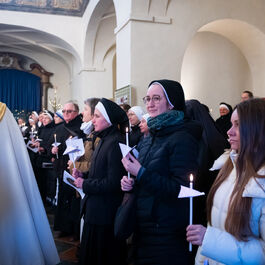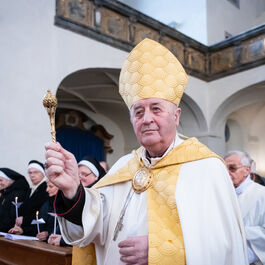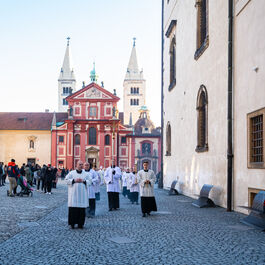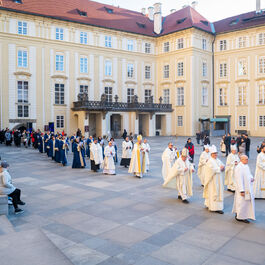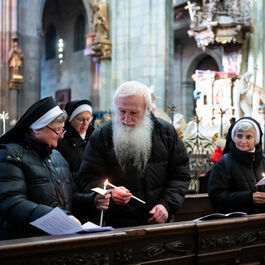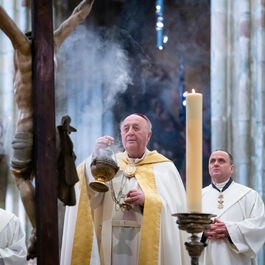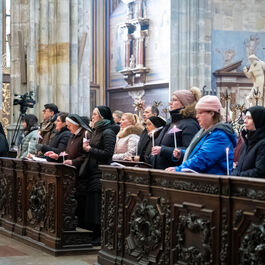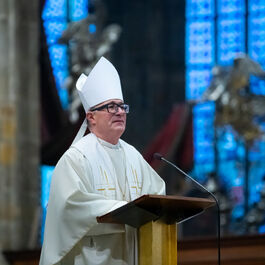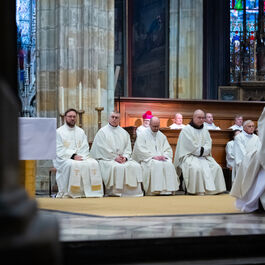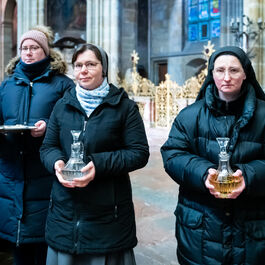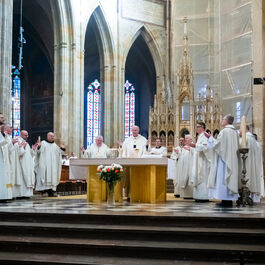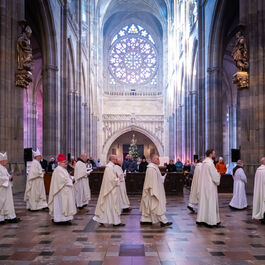Celebration of the Lord's Presentation in the Cathedral 2025
The Feast of the Presentation of the Lord has been a celebration of consecrated life since 1997. This year, in 2025, the celebration fell on Saturday, February 1. Our community participated in this gathering at the Prague Cathedral, where a Holy Mass was held at 10 a.m., preceded by a candlelight procession from the Church of All Saints.
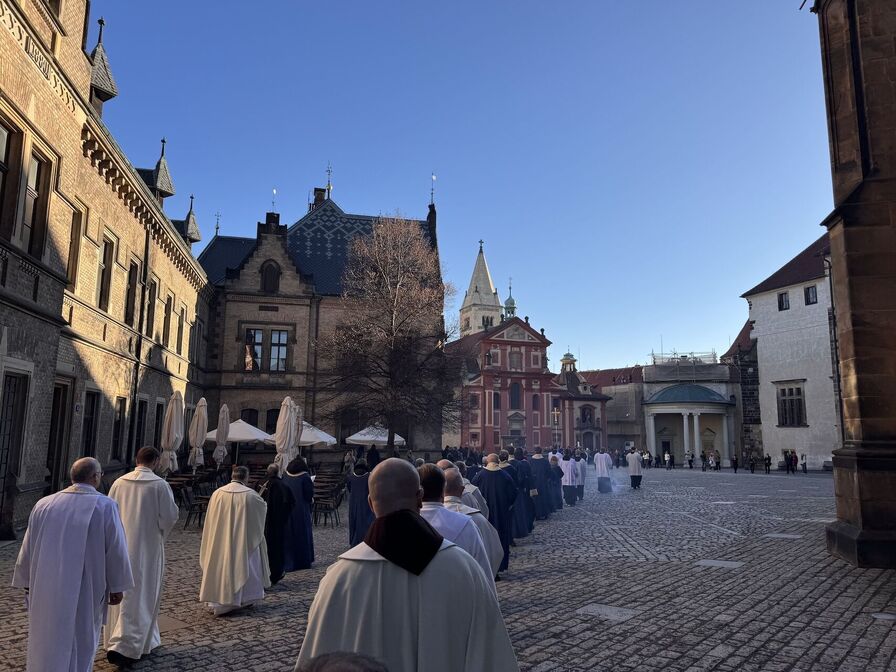
Created on: 2. 2. 2025
The Feast of the Presentation of the Lord has been a celebration of consecrated life since 1997. This year, in 2025, the celebration fell on Saturday, February 1. Our community participated in this gathering at Prague Cathedral, where a Holy Mass was held at 10 a.m., preceded by a candlelight procession from the Church of All Saints.
The following is the homily delivered by our Abbot, Daniel P. Janáček, on this occasion. The photographs in the photo gallery were taken from the Člověk a víra website, and we sincerely thank Lucie Horníková for capturing them.
Homily by Our Abbot Daniel P. Janáček
He waits again for her to come. This time, He wanted to come directly to her city. She knew the way. So, she set out to meet Him, holding a candle in her hand.
No, this is not the beginning of a romantic story, but rather an attempt to draw closer to the mystery of our Feast of the Presentation of the Lord. Just weeks after Advent, the Church once again waits for His coming. Just as at Christmas, she celebrates His arrival. Christ comes to His temple, and we go to meet Him in procession, holding candles. Through the antiphon, we proclaim: "Jesus comes as Lord and Mighty Ruler and is the light for those who follow Him."
The mystery of today's feast and its profound meaning are reflected in its various names:
"The Purification of the Blessed Virgin Mary" – this was the name of the feast before the liturgical reform. According to the Law of Moses, a Jewish woman was considered impure after childbirth and had to be purified through a burnt offering. Jesus and Mary did not need purification, yet they submitted to the Law of the Lord. As St. Paul writes to the Galatians: God sent His Son, born of a woman, born under the Law, to redeem those under the Law, that we might receive adoption as sons. (Gal 4:4)
The Czech name "Hromnice" refers to the candles, whose fire and light symbolized security and hope in times of crisis for our ancestors. The burning candle in our hands symbolizes Christ. The pure wax represents His human body, born of the Virgin Mary without compromising her virginity. The wick hidden within the wax symbolizes His pure soul dwelling in His body. The flame and light signify His divinity and His divine teaching that enlightens all people.
We cannot grasp God as humans, nor can we possess Him—He gives Himself into our hands. Just as we take a candle into our hands, so too do we take hold of Christ in faith, who is our salvation, our light, and our true life. With love, we offer ourselves to the Father along with Him. His light shines upon Mary and Joseph, upon Simeon and Anna, and through them, upon all of us.
The Church Fathers associated the radiance of His light with the spiritual journey. They called the Christian life philokalia—"love for Divine beauty." The light of this beauty shines on the face of Christ. The Church contemplates the transfigured face of Christ to strengthen herself in faith and not to falter before His disfigured face on the Cross. The Church is the bride standing before the bridegroom, sharing in His mystery and wrapped in His light. (Benedict XVI)
In some places, this feast is called "The Presentation of the Lord." We all share in the mystery of His self-offering, where glory and the cross, light and suffering, are inseparably united. This is also a Marian mystery, in which Jesus' mother is foretold the martyrdom of her soul. Today, a unique offertorium is celebrated—the mystery of self-giving, which is essential to Christian existence (John Paul II). Today, we are given the opportunity to renew our own self-offering and grow in our inner being.
In the East, this feast is called "Hypapante," the Feast of the Encounter. Simeon and Anna, meeting Jesus in the temple, embody the pious people of the Old Covenant—the "remnant of Israel," who are watchful and ready to meet Him—as well as the new people who meet their Lord in the Church. Here, the meeting of the Old and New Laws takes place, the first and the second. Jesus, who is the new Temple of God, comes to the old temple, to His Father's house. He comes—obedient to the old law—to visit His people and to open a new time of salvation.
In 1997, Pope John Paul II declared this day as the "Day of Consecrated Life." In the introduction to his Message, he states that the mission of consecrated life concerns not only those who have received this special charism but all Christians.
He gives three reasons for establishing the Day of Consecrated Life:
- To praise the Lord and give thanks for the gift of consecrated life. We must never forget that consecrated life is not the result of our human effort but the initiative of the Father—a gift from above.
- To promote knowledge and appreciation of consecrated life within the entire People of God.
- To encourage consecrated persons to recognize their mission and place in the world. They are invited to celebrate together the wonders the Lord has worked for them and to perceive more clearly the rays of divine beauty with which the Spirit has adorned them. The Pope believed that this day would help consecrated persons return to the source of their vocation, evaluate their lives, and reaffirm their commitment to their consecration. Thus, they can joyfully bear witness that the Lord is love and that He alone can fulfill the human heart.
Brothers and sisters, allow me to ask a few questions:
Where is our passion for God?
Where is the enthusiasm of our faith?
Where is our joy in being a Christian, a priest, a monk, or a nun?
Where is our first love?
Where is our happiness in knowing and serving God?
Do we constantly complain, criticize everything and everyone, and feel sorry for ourselves?
We may use every available means to try to revive ourselves, our communities, pastoral units, and parishes, creating new structures—yet we end up realizing that we are just patching things up. We feel empty, exhausted, and burned out. Prayer can become a routine and an obligation. God may seem distant.
We spend our entire lives searching for the perfect and optimal—at work, in leisure, in relationships. We seek happiness, yet we are never truly satisfied.
Is there salvation, healing, and redemption in our fragile and suffering world, marked by violence, wars, exploitation, spiritual hunger, and sickness?
What can we do when the vessel of our life is empty and our resources are depleted?
Mother Teresa once shared a story:
"I visited an old man in Melbourne whom no one knew existed. His room was in a terrible state. I wanted to clean it, but he kept saying, 'I'm fine.' There was a beautiful lamp in the room, but it was covered in dust. 'Why don't you light it?' I asked. 'For whom?' he replied. 'No one ever comes to me; I don’t need a lamp.' I continued, 'Would you light it when the sisters come to visit you?' 'Yes,' he said. 'Yes, if I hear a human voice, I will light it.'
One day, he sent me a message: 'Tell my friend that the light she lit in my heart still burns.'
Simeon proclaims: "My eyes have seen your salvation… a light for revelation to the Gentiles and for glory to your people Israel."
Brothers and sisters, will we allow Simeon and Anna to encourage and inspire us?
To wait with hope, even when all seems against it?
To seek and cherish God's presence?
To be amazed by Jesus and speak of Him to others?
What God did for Simeon and Anna, He desires to do for us as well.
May our eyes see more than a child.
May we recognize our Savior in the Crucified One, our Teacher in His word, and our Love in the Bread and Wine.
Daniel Peter Janáček O. Praem.


